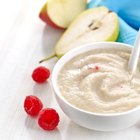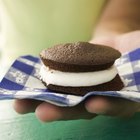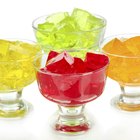changephoto/iStock/GettyImages
The dairy section of most grocery stores is no longer limited to milk and products that come from milk. You'll also find nondairy creamers in a range of flavors, as well as nondairy drinks made from soybeans, almonds and coconut. While nondairy creamers exist to give the illusion of creaminess in coffee drinks, they are not identical to dairy cream.
Ingredients
The major way that cream differs from creamer is in the ingredients. While the primary ingredient in cream is simply cream, nondairy creamers are made from an assortment of ingredients. The primary ingredients in creamers are corn syrup solids and vegetable oils. The oils are responsible for the creamy texture of the creamer, and annatto food coloring and artificial flavors help make the creamer more closely resemble the real thing, according to "Wired" magazine. Nondairy creamers technically don't contain milk, although they might contain milk ingredients, such as casein, a protein. They are not suitable for people with milk allergies or those who follow a completely vegetarian diet.
Types of Cream
Dairy cream is sold in many varieties, such as half-and-half, light cream and heavy cream. The amount of fat in each type determines what it is and how you can use it. Half-and-half has the least amount of fat, with a fat content of 12 percent. Light cream and half-and-half are commonly used to enrich coffee. Heavy cream is at least 38 percent fat and is suitable for whipping or for making cream-based sauces. Creams meant for spreading, such as clotted cream or plastic cream, contain more than 50 percent fat. A higher fat content means that the cream can be heated or boiled without curdling.
Shelf Lives
The shelf life of cream and nondairy creamer is substantially different. Cream can be either pasteurized or ultra-pasteurized. pasteurized cream is heated to 155 or 165 degrees Fahrenheit for 30 minutes. Ultra-pasteurized cream is heated to 280 F for two seconds. Pasteurized cream has a shelf life of about two weeks, while ultra-pasteurized cream will keep for about twice as long. Powdered nondairy creamer has a considerably longer shelf life of up to two years when stored at room temperature. In the liquid form, it will keep for about two weeks after being opened when stored in the refrigerator.
Nutritional Differences
Creamer and cream are similar when it comes to calories, although the source of the calories differs. Half-and-half contains 20 calories per tablespoon from 2 grams of fat and 1 gram of carbohydrate. The powdered form of a nondairy creamer has 30 calories per tablespoon, with 1.5 grams of fat and 3 grams of carbohydrates. The liquid version contains 20 calories with 1 gram of fat and 2 grams of carbohydrates. A tablespoon of heavy cream contains 52 calories, 6 grams of fat and no carbohydrates.
Related Articles

Calories in a Tablespoon of Cream Cheese

How Many Calories Are in Cream of Wheat?

Can You Water Down Heavy Cream to Make ...

Why Does Some Alcohol Curdle Cream?

Can You Make Instant Pudding With Heavy ...
Clotted Cream Vs. Double Cream

Why Does Cream Turn Into Butter?

Differences Between Double Cream and ...

Heavy Whipping Cream Vs. Half & Half

Can I Sub Condensed Milk for Cream in ...

What Are the Ingredients in Elizabeth ...
Differences in Half & Half Vs. Cream ...

Different Types of Whipping Cream

What Else Could You Use Besides Cream ...

How to Substitute Cream for Buttermilk

Fat-Free and Sugar-Free Jell-O Pudding ...
What Do Bakeries Use in Their Whipped ...
How Can I Prepare Whipping Cream Ahead ...

How to Bring Cream to a Boil
The Difference Between ...
References
- Wired: What's Inside Powdered Nondairy Creamer
- On Food and Cooking: Harold McGee
- Self Nutrition Data: Half-and-Half
- Self Nutrition Data: Heavy Cream
Writer Bio
Based in Pennsylvania, Emily Weller has been writing professionally since 2007, when she began writing theater reviews Off-Off Broadway productions. Since then, she has written for TheNest, ModernMom and Rhode Island Home and Design magazine, among others. Weller attended CUNY/Brooklyn college and Temple University.